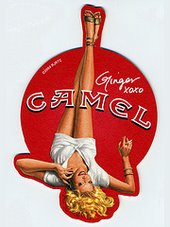
Zippo: Hand Warmer
Showing posts with label car driver smokes. Show all posts
Showing posts with label car driver smokes. Show all posts
Tobacco thrown from the finish. Congress of the United States against cigarette advertising in women's magazines.

American parliamentarians continue to fight smoking. Several dozen members of Congress require publishers Cosmopolitan, Vogue, Glamour and other popular magazines to stop print advertisements of tobacco, as well as smoking is a danger to the health of women and adolescents.
This week, a group of 41 deputies sent a letter to 11 publications, which is trying to convince them that publish tobacco advertising next to the articles on the health of women impossible farce. The greatest concern aroused Congressmen No Camel brand.
Nine cigarettes are in the new graceful bundle (Hct with black-colored sea waves or fuchsia) production R. J. Reynolds. They advertise specifically as women's cigarettes.
"We are extremely concerned that R. J. Reynolds, aggressively imposing this devastating product to young women, makes extensive use of leading women's magazines, including you, "says the message of parliamentarians, and transmitted to the press.
Representatives of R. J. Reynolds claimed in response that its new cigarettes that appear in magazines in the face of roses are intended solely for experienced adult smokers.
But organizations involved in the fight against smoking, are confident that the new company is going to cigarettes, on the other hand, attract non-smoking girls.
"More than a thousand customers tobacco companies are dying every day from diseases associated with smoking, of course, they know what to talk about when the documents for internal use Teenage called" potential smokers", which will come to replace them," the letter Congressmen.
Advertising in the United States

It should be noted that advertising in the United States have waited two major boom. The first refers to the 1920-m: lack of sales techniques, the movement to the touch with the dramatic increase in the production of goods and products whipped up competitors to increase advertising budgets.
What all this ended well-known. Overproduction of goods compared with the solvent demand advertising did not help, and this is the Great Depression.
The second period is also flourishing advertising account for the post-war decades of the twentieth century. Advertising 1920-x in America was largely traditional appearance, creative strength mainly scooped copy of the best European designs. Copying the King was an American advertising; it was responsible for the whole concept of Graphic Design USA.
While new products and all products come and arrived at the consumer market, advertising does not move from their seats and remained on the traditional songs, compiled from the title, illustrations, text, and a signature.
Echo style modernism or art-novo survived advertisements 1920-x; they dominated the natural and graceful shape. The advertising business does not know what to do with new ideas currents of European modernism.
Randall Lester, president of New York Art-director Club, warned overseas designers: "Art Director Responsibility is to be cautious and wise in the use of his extreme views. There are so many ways to solve the problem of fiction, but there are artists”.
Unlike previous decades, in which the Great Depression and the Second World War condoned thrift and rationing of consumption, Americans 1950-x experienced unprecedented purchasing boom. All of this is preparing the ground for strengthening the role of advertising in the sale.
Despite the shadow of the atomic destruction hanging over the consciousness of Americans, advertisers have continued to treat the public, products, which were more new, better and faster, creating a new "mass market". And the Americans feel to have the right to do so.
In seeking to lead a normal life, the American public watched closely in the future and the future seemed unclouded. At least, as it looked through the prism of television, magazines and advertising cigarettes.
Subscribe to:
Posts (Atom)
















